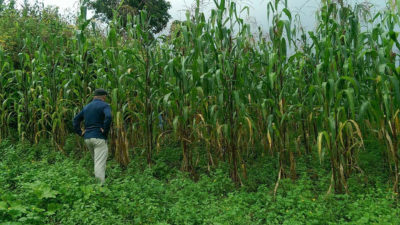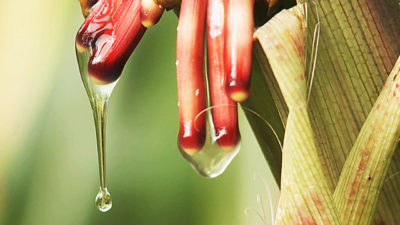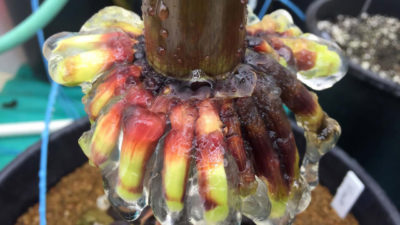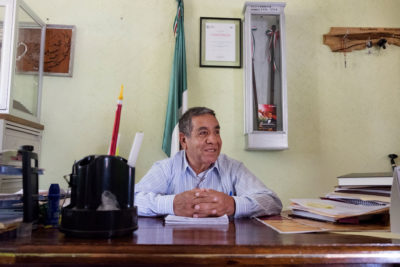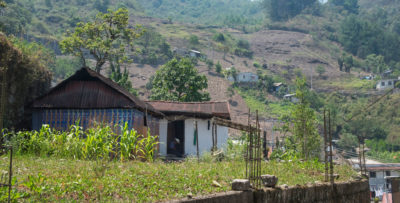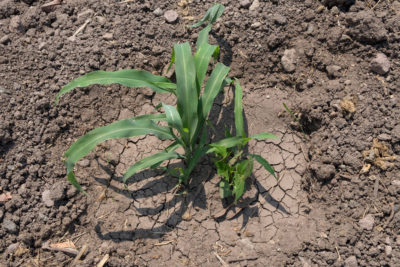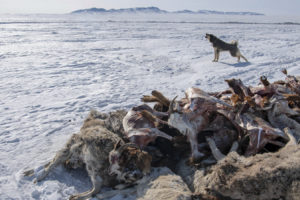In a 1979 visit to Totontepec, a small town in Oaxaca, Mexico, naturalist Thomas Boone Hallberg marveled at the local maize. The plants grew nearly 20 feet high in nutrient-poor soil, even though local farmers did not apply any fertilizer.
The maize had aerial roots that grew a mucous-like gel just before harvest season. It seemed impossible, but Hallberg wondered if the maize was fixing its own nitrogen: extracting it from the air and somehow making it usable for the plant. He had visited countless towns since moving to Oaxaca in the 1950s, but what he saw in Totontepec stuck with him.
In 1992, Hallberg returned with a group of Mexican scientists. The maize, known as olotón, was almost ready for harvest and its aerial roots glistened with gel. Ronald Ferrera-Cerrato, a microbiologist, took samples back to his lab outside Mexico City to test the bacteria in the gel. His preliminary results, published in a 1993 report, showed that the maize received nitrogen from the air, through its aerial roots, but his work did not prove that those bacteria were capable of actually fertilizing the corn.
At the time, scientists around the world were puzzling over similar questions. In a 1996 paper in Plant and Soil, microbiologist Eric Triplett, then at the University of Wisconsin, described the possibility of corn plants that fix nitrogen as “the ‘holy grail’ of nitrogen fixation research” because of the potential to reduce fertilizer demand.
It took more than two decades before the suspicions about Totontepec’s maize were confirmed in a peer-reviewed journal. Last August, researchers from the University of California, Davis, the University of Wisconsin, and Mars Inc. — the global food and candy conglomerate — published the results of a 10-year study in PLOS Biology, describing how bacteria that thrive in the low-oxygen environment of the maize’s mucus pull nitrogen from the air and feed it to the plant.
Scientists will likely spend years determining if a commercial application of the maize is viable.
The media celebrated the findings. “The wonder plant,” trumpeted The Atlantic. Smithsonian declared: “The corn of the future.”
The scientists provided few details about where the maize came from, or the circumstances of what UC Davis touted as the researchers’ “remarkable discovery,” saying only that the corn was from an isolated village in Oaxaca. A Mars subsidiary called BioN2 had signed an agreement with a village to share financial benefits from the maize’s commercialization. That village turned out to be Totontepec, a Mixe indigenous community in the mountains of eastern Oaxaca.
Scientists will likely spend years determining if a commercial application of the maize is viable. But if the trait is successfully bred into commercial corn, farmers could substantially reduce their use of synthetic fertilizer. Farmers spend more than $3 billion a year on corn fertilizer in the United States alone. Nitrogen fertilizer is also a leading cause of water pollution, dead zones in rivers and lakes, and an important source of greenhouse gases.
The UC Davis/Mars researchers received a certificate of compliance with the Nagoya Protocol, an international agreement aimed at compensating indigenous communities for their biological resources and traditional knowledge. Still, the situation surrounding Totontepec’s maize raises complex questions about how indigenous communities equitably benefit when research scientists and multinational corporations commercialize local crops and plants. Should Totontepec’s maize turn out to be a miracle, self-fertilizing crop whose genetic traits can be replicated worldwide, will the community’s Mixe people receive a significant long-term share of profits, which could potentially number in the millions of dollars? How does Nagoya ensure that the rights and interests of small indigenous communities are safeguarded when their leaders negotiate complex deals with international lawyers and executives? And, not least, when a valuable plant is found throughout a region, is it fair for a single village such as Totontepec to reap financial benefits from its maize while neighboring communities with identical or similar maize receive nothing?
The maize variety olotón has aerial roots that produce a mucous-like gel that fixes nitrogen, meaning that it can effectively fertilize itself. Mars, Incorporated & Jean-Michel Ane/UC Davis
Alejandro Ruiz García, an agronomist from Guelatao, Oaxaca who accompanied Hallberg to Totontepec in 1992, thinks that other communities that grow olotón should also have a say in the future commercialization of the corn and share in any profits. “This is part of our cultural and agricultural heritage,” he said. “The debate is just getting started.”
Indeed, Totontepec’s maize is a reminder that the policies meant to safeguard the genetic resources of indigenous communities, in Mexico and around the world, are very much a work in progress. Some bright spots have emerged, but fair, long-lasting agreements are rare.
Biopiracy is defined as the exploitation of indigenous knowledge and biological resources without permission. The practice goes back centuries. International companies have exploited the botanical riches of the Amazon, for example, for well over a century, from the expropriation of the seeds of Brazilian rubber plants in the 1870s to the modern-day controversy over the international patenting of the Amazon’s Cupuaçu fruit. Even before the Nagoya Protocol, countries such as Costa Rica took steps to regulate bioprospecting. Some indigenous people have taken a proactive approach to negotiating agreements, instead of relying on national governments. In Panama, the Guna people decided that their General Congress, which represents dozens of communities, must approve any research projects, commercial or otherwise.
Since Nagoya went into effect, some scientists have raised concerns that countries have placed onerous requirements on researchers, discouraging scientific inquiry. But indigenous communities and advocates worry that exploitation continues. Because the details of the arrangement negotiated between the Totontopec community and UC Davis/Mars remain largely confidential, journalists, scientists, and farmer advocates in Mexico have spoken out against the deal, with some even accusing the U.S. side of biopiracy.
But Alan Bennett, a professor of plant sciences at UC Davis and a leader of the maize research project, dismisses that contention, saying his team worked in good faith, enlisted the participation of the Totontopec community, and followed the guidelines of the Nagoya Protocol. “We really crafted something that I would be proud of,” Bennett said in an interview, while acknowledging he had not seen the final version of the agreement.
“We’ve worked hand in hand with the Mexican community on this research,” said a spokeswoman for Mars.
A spokeswoman for Mars added, “We’ve worked hand in hand with the Mexican community on this research.” Mars says it shared information in community assemblies and consulted with the Mexican federal government. And Howard-Yana Shapiro, the chief agricultural officer of Mars, said in an interview that the decision to work with only one community was made “at the [Mexican] government’s urging” because it was seen as the most efficient way to comply with Nagoya.
A preliminary version of the access and benefits-sharing agreement, which was seen by Yale Environment 360 and the Food & Environment Reporting Network, says UC Davis holds patent rights and that net income from any patent royalties would be shared 50-50 with the Totontepec community. Bennett said leaders in the community requested that the agreement remain confidential, but he confirmed that Mars has already paid $100,000 to Totontepec as part of the agreement.
The Mexican government has not played an active role in ensuring that the rights of the Totontepec community are safeguarded. In 2015, when Mexico issued a Certificate of Compliance to BioN2, the federal government did not have a standardized process to handle requests from companies and universities to access biological resources from indigenous communities. Bennett says both the researchers and the federal government were learning as they went along. The Mexican government adopted a “transitional process” in 2017. The Mexican Secretariat of Environment and Natural Resources, charged with implementing Nagoya, and the National Seed Inspection and Certification Service (SNICS) declined repeated interview requests.
Totontepec’s current municipal president, Luis Adolfo Alcántara Nuñez, says he does not know the details of the final agreement and that the community’s four agrarian commissioners are the only people authorized to comment on it. Yale e360 was unable to interview the commissioners because they were not in session during a visit to the community and have not been available by phone since.
Totontepec is a small town high in the misty mountains of Oaxaca in southern Mexico. It is a four-hour drive, full of hairpin turns and panoramic views, from the state capital of Oaxaca city. Totontepec overlooks Zempoaltepetl Mountain, the highest point in the state and a sacred site for the Mixe, who number an estimated 119,000 people.
Totontepec is an indigenous agrarian community, and its land is held communally. Many residents are subsistence farmers who depend on the three crops of the milpa, the building blocks of indigenous agriculture in Mesoamerica: maize, squash, and beans. Olotón is one of the 59 maize landraces, or native varieties, in Mexico. Indigenous farmers domesticated landraces over millennia, carefully selecting and saving seeds for generations to meet their specific climatic and culinary needs.
Juan Arelí Bernal Alcántara grew up in a family of farmers in Totontepec. He remembers the children in town would follow their parents to the fields and play with the strange mucilage that forms on the maize’s aerial roots, even eating it. After studying agronomy near Mexico City, Bernal became Totontepec’s unofficial agronomist. Bernal hosted Thomas Boone Hallberg and a group of scientists when they came to town in 1992. “The idea was for more scientists to see our maize, and to encourage more research,” says Bernal.
Ronald Ferrera-Cerrato, one of the scientists who went on the 1992 trip, is a microbiologist at the Postgraduate College Montecillo campus outside Mexico City. He tested the gel he brought back, finding evidence of nitrogen-fixing bacteria. But after a 1995 publication, he didn’t pursue the research further, lacking funding for the complex testing to prove nitrogen-fixation.
More than 20 years later, Jean-Michel Ané, a University of Wisconsin microbiologist, picked up where Ferrera-Cerrato left off, though the two men had never heard of each other. Ané says he met Shapiro and Alan Bennett in 2009. Metagenomics, the study of genetic material recovered from environmental samples, offered new possibilities to understand nitrogen fixation. Shapiro and Bennett invited Ané to study a maize variety from Oaxaca that they suspected fixed nitrogen. Intrigued, Ané said yes.
Bennett had already begun collecting maize samples in 2006 in Totontepec under a simple material transfer agreement with the community. He says he and Mars were always transparent, presenting updates at the agrarian community’s assemblies and taking votes. Residents of Totontepec confirmed that the researchers frequently attended assemblies.
Olotón is a staple crop for the Mixe indigenous people in the Sierra Mixe region, including in Totontepec, pictured here. Citlali Fabián
Azarel Rivera Bernal grew up in Totontepec and now lives in Oaxaca City. But he participates in local government and attended assemblies where the scientists spoke. Even so, he was surprised to see the Nagoya Protocol certificate of compliance for the first time and wondered what it really meant for his community. “My fear is that they will privatize our seeds and we will no longer be able to plant them,” he said.
The UC Davis/Mars researchers exported maize samples from Mexico for at least nine years before receiving a permit from the Mexican government in 2015. Bennett said that the U.S. side did not believe it was necessary to consult with the federal government because indigenous communities are autonomous under the Mexican Constitution.
Shapiro says it could take more than a decade for Mars or another company to breed the nitrogen-fixation trait into a commercial corn variety, if it is possible at all. Bennett says research continues at UC Davis to better understand and isolate the bacteria that fix nitrogen in the maize gel.
People familiar with the Totontepec case say it highlights some important shortcomings of the Nagoya Protocol, which went into effect in 2014. (While the U.S. is not a signatory, American companies must follow its principles if they operate globally.) One is that Nagoya allows confidential agreements, despite transparency being a primary purpose of the protocol. For companies and universities, confidentiality is key to preventing their research from being copied.
But for communities and advocates, it can prevent outside observers from assessing the fairness of the agreements between communities and multinational conglomerates. Word of the maize agreement only started to spread in Oaxaca when the digital outlet Animal Político published a story in November, years after the agreement had been signed. Some countries, like Peru and South Africa, have taken steps toward more transparency, saying that when a company applies for a permit, the name of the species being accessed and the applicant must be made public.
Researchers have documented that the nitrogen-fixing maize is grown in other parts of Oaxaca and even Guatemala.
Advocates for indigenous communities say it’s important that they have access to third-party mediators to ensure they are fully informed and their rights safeguarded. “In any negotiation when you have parties that have very different resources and unequal access to information, it is helpful to have independent parties that can provide support or mediation,” says Maria Julia Oliva, of the non-profit Union for Ethical BioTrade.
An important issue in the Totontepec case is the decision by Mars Inc. and UC Davis researchers not to consult or compensate other communities that grow olotón. Ané and other researchers have documented that the nitrogen-fixing maize is grown in other parts of Oaxaca and even Guatemala. Shapiro referred to Totontepec as the “centerpiece” of the region and said the community had long “shared its material with other communities,” though there is no research indicating that the aerial root-producing olotón originated in Totontepec.
That only Totontepec would receive compensation for the commercialization of a crop that is a regional natural resource strikes other communities and some outside observers as unjust. Once Ané realized that the nitrogen-fixing maize was not exclusive to Totontepec, he says he felt conflicted about the research. When his contract with Mars was up at the end of 2017, he did not renew it. He thinks the maize should be kept in the public domain and made available to small-scale farmers around the world.
Other countries have found ways to compensate multiple communities for a geographically dispersed resource. The hoodia plant, used in appetite suppressants, grows in the Kalahari Desert and has traditionally been used by the San people of South Africa, Botswana, and Namibia. After initially being excluded from benefits derived from patented hoodia medicines, the San and allies in the non-profit community negotiated an agreement in the 2000s, to create the San Hoodia Benefit-Sharing Trust, which could ultimately bring significant financial benefits to the San people. The San also decided that benefits should be collective, instead of restricted to individual communities, because hoodia is not “owned” by a single community.
The mucus-producing maize can grow nearly 20 feet high in nutrient-poor soil, without the use of additional fertilizer. Citlali Fabián
Laurent Gaberell of the Swiss non-profit Public Eye says that the International Treaty on Plant Genetic Resources for Food and Agriculture, a parallel agreement to Nagoya, is meant to regulate access to staple crops that are spread across many communities. The treaty acknowledges that these resources are not the property of a single community and that benefits must be shared. Maize is one of the crops the FAO treaty covers, but Mexico has not ratified it. Mexico has no legal procedure that regulates how to consult and compensate communities, and in the absence of national legislation, companies have significant leeway.
“It’s a failure on the part of Nagoya and it’s a failure on the part of the Mexican government,” says Jack Kloppenburg, a seed expert at the University of Wisconsin. “If both parties are allowed to operate this way, the whole exercise is pointless… …Nagoya is legitimizing biopiracy.”
The administration of Mexico’s new leftist president, Andrés Manuel López Obrador, has spoken in favor of small-scale farmers and indigenous rights. Victor Suárez, a long-time leader in farmer organizations in Mexico, is now sub-secretary in the newly created office of Food Self-Sufficiency. “In this new government, we are not going to allow policies to continue that privatize genetic resources of our population, especially collective resources of indigenous communities,” he said in an interview.
In the meantime, as U.S. researchers continue the daunting task of attempting to transfer the nitrogen-fixing genetic trait to commercial corn varieties, the farmers of Oaxaca will keep on planting their miracle maize as they have for thousands of years.
Correction: July 22, 2019: An earlier version of this story incorrectly characterized the research conducted by Mexican scientist Ronald Ferrara-Cerrato. He showed that the gel in the olotón maize contained nitrogen-fixing bacteria, but he did not prove that those bacteria were capable of actually fertilizing the corn.
This article was produced in collaboration with the Food & Environment Reporting Network, a non-profit investigative journalism organization.
